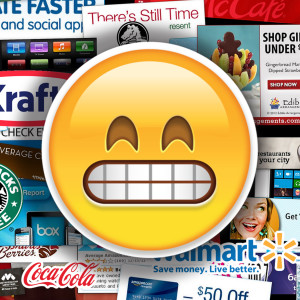Lessons from 2015: Breaking Through in Contemporary Ad Space
Somewhere in the mid-1950s, a revolution in advertising took place. While previous business models relied primarily on supply side economics, the new age of advertising saw opportunities to generate demand through innovative marketing practices. The behavioral sciences slowly started to work their way into advertising agencies and businesses began to devote substantial portions of their budgets to product promotion.
Enter present day. In one of our previous posts, Greg Hill mused about the exasperatingly omnipresent nature of advertisements. From billboards and gas pumps to YouTube videos and Twitter feeds, from mailboxes to inboxes, from every step of our waking lives and practically into our dreams, we are constantly bombarded with a non-stop stream of product promotion, sales notifications and brand awareness campaigns. It can all be, in a word, exhausting, and exhausted consumers have the tendency to shut it all out in the hopes of a moment of solace.
So, how do you break through?
This Year’s Hits
It may be a little early for 2015’s retrospective, but the year is quickly coming to a close and it’s not entirely too soon to figure out which marketing campaigns will be getting the consumer kiss when the ball drops. Over the summer, Forbes and Adweek released their lists of the most successful ad campaigns of 2015 so far. As would be expected, both lists contained entries that fully employed a variety of social media platforms to reach out to target markets in their online homes.
Entry number one on the Forbes list was the World Wild Life Funds vine campaign, while contender number three for Adweek was an Italian PSA from Fanpage. In both cases, the campaigns used emotionally effective narrative devices to reach out to their audiences in ways that stuck. The WWF used the fact that vine videos disappear after ten seconds to illustrate the ease of species extinction, while Fanpage used a short video of young boys infatuated with a pretty young girl to illustrate the innate refusal of domestic violence within the innocence of childhood love. Both campaigns achieved tremendous visibility with one key difference: Fanpage is neither a non-profit nor anti-domestic violence group.
The success of the Fanpage campaign sheds light on the trend of the other top contenders for market visibility in 2015. The production orientation era of the early 1900s has been dead for over a century. With near market saturation for ad space, simply informing consumers about the quality and availability of your brand or product is not anywhere near enough anymore. Fanpage and countless other businesses managed to implement campaigns that successfully reached out to their markets and audiences in ways that struck a genuine emotional cord. This rang true for other top contenders like Budweiser’s heart-warming one minute video about a rancher and his adorable puppy, Android’s montage of interspecies friendships and Honest Tea’s campaign revolving around the National Honesty Index. The common thread of advertisements with the highest visibility was a multimedia narrative that had very little to do with the actual product being sold and everything to do with sincerely moving people.
A Captivated Audience
You only need to look as far as the tremendous success of TiVo and DVR in the early 2000s to illustrate how far people will go to avoid ads. Timed recording for missed TV shows has been around for decades. It wasn’t the opportunity to conveniently catch and store people’s favorite TV shows that made for the outstanding commercial success of DVR. It was the ability to skip commercials. Years later, Netflix remains staggeringly dominant over other online film libraries because of their awareness and willingness to cooperate with the desires of their user base; namely, to avoid ads at all costs.
When people aren’t paying to avoid ads, they’re instinctually putting up barriers, at which point, successfully breaking through depends on your marketing approach. The term audience and market have been used interchangeably in this piece to communicate a point. At its best and in its successes, effective marketing becomes almost or entirely indistinguishable from entertainment. When commercials were unavoidable on television, audiences frequently remembered particularly clever or amusing ads better than the shows themselves. Marketing mascots like the Geico gecko and Dos Equis’ Most Interesting Man in the World have become beloved icons in pop culture and our shared social experience, while, for quite some time, the super bowl ads have become an inseparable spectacle to the sporting event itself. When an advertisement is entertaining enough, audiences are willing to engage in spite of their natural hesitance and, in the process, form strong associations with both the ad and its brand.
The bottom line is that in order to compete in the daunting modern gauntlet of intellectual ad space, you have to stand out from the deafening clamor of self-promotion and break through the stone wall of consumer fatigue. The only way to accomplish this is to show your audience a side of your business that resonates with them on some substantial emotional level. Make them forget that they’re experiencing an ad in the first place. A commercial should be viewed like a moving short film. A billboard should appear as a gallery piece in public space. A blog post should read as an excerpt of memorable prose. In the cluttered contemporary landscape of marketing and advertisement, the only way to set yourself apart is to move your audience in order to move your product.
Mehran is an amateur philosopher, aspiring pool shark, classically trained pianist and enterprising copywriter with a background in the life sciences and psychology.

